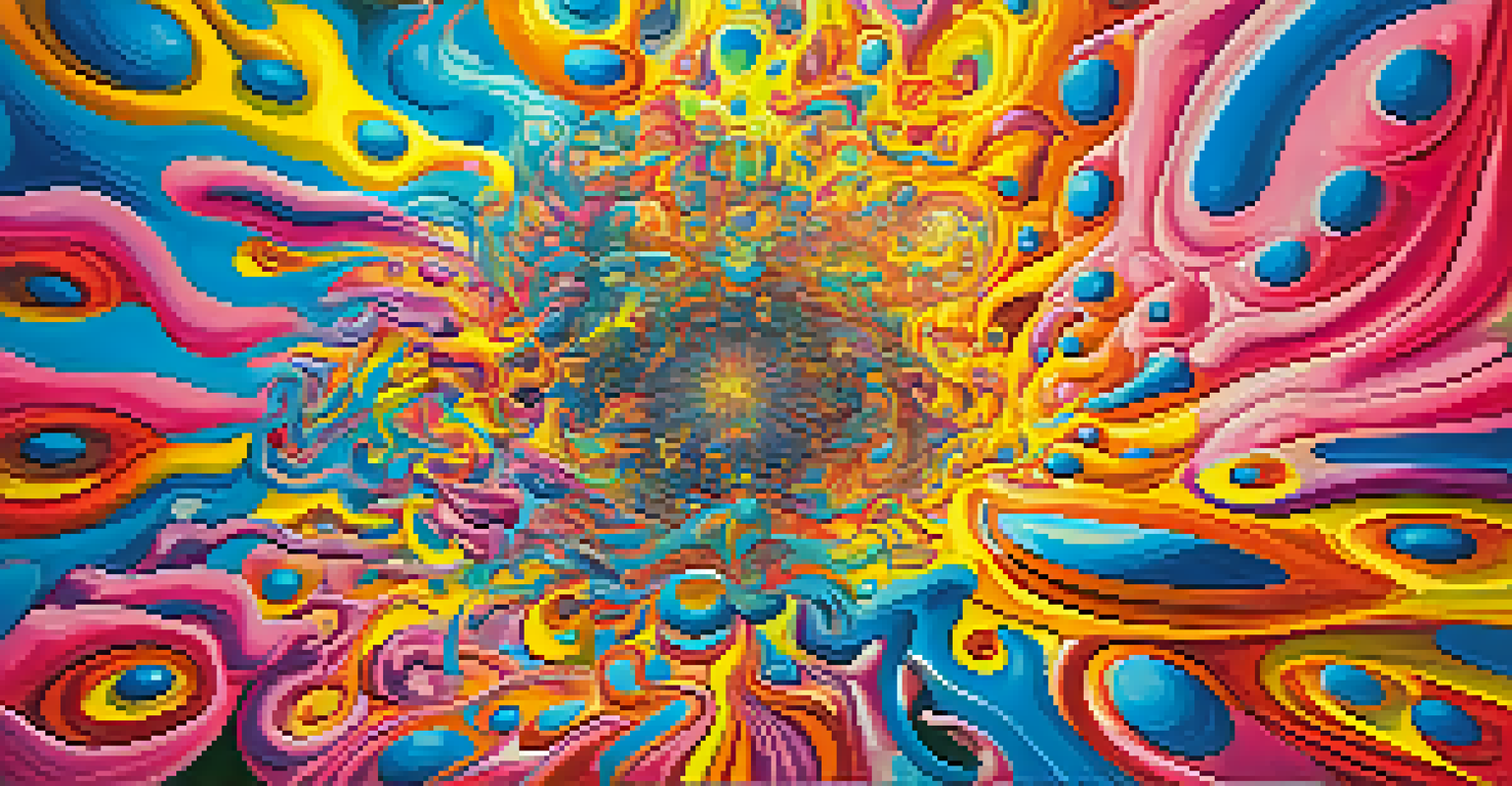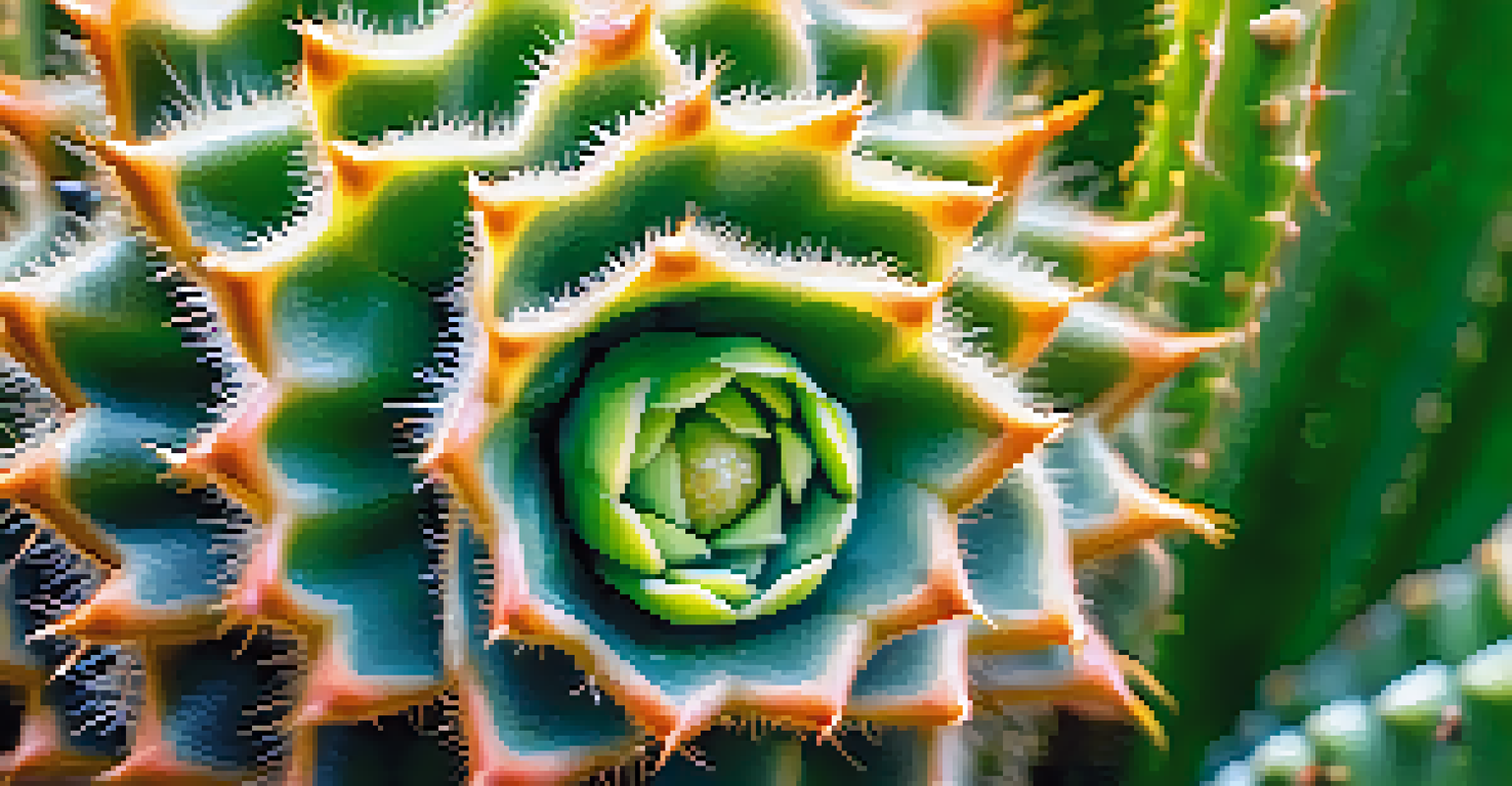Psychedelic Experiences: Peyote and Its Comparison with LSD

Understanding Psychedelics: An Overview
Psychedelics are substances that alter perception, mood, and cognitive processes. They have been used for centuries in various cultures for spiritual and healing purposes. Peyote, a cactus containing mescaline, and LSD, a synthetic compound, are two notable examples that offer unique experiences.
The psychedelic experience connects individuals to a deeper sense of self and the world around them.
Both Peyote and LSD affect serotonin receptors in the brain, leading to altered states of consciousness. However, their origins and cultural contexts vary significantly. Peyote has deep roots in Indigenous American rituals, while LSD emerged from 20th-century research into mental health.
Related Resource
Understanding the distinctions between these substances can enhance our appreciation of their effects. By exploring their histories and applications, we can better grasp how they impact our minds and societies.
The Historical Significance of Peyote
Peyote has been used for over 5,000 years, primarily by Indigenous peoples in North America. It serves as a sacrament in various spiritual ceremonies, particularly among the Native American Church. This historical significance highlights its role not just as a drug, but as a tool for connection to the divine.

The consumption of Peyote often leads to profound introspection and a sense of unity with nature. Participants report vivid visuals and deep emotional releases, which can facilitate healing and personal growth. This cultural context adds layers to its experience, making it more than just a psychedelic journey.
Psychedelics Alter Consciousness
Psychedelics like Peyote and LSD change perception, mood, and cognitive processes, offering unique experiences rooted in different cultural contexts.
Understanding Peyote's historical significance enriches our perspective on its effects. It's essential to acknowledge the traditions and practices surrounding its use to appreciate its impact fully.
LSD: The Revolutionary Psychedelic
LSD, or lysergic acid diethylamide, was first synthesized in 1938 by Swiss chemist Albert Hofmann. Its discovery marked a significant turning point in both psychology and culture, leading to a fascination with altered states of consciousness. The 1960s counterculture movement further propelled its popularity, associating it with experimentation and liberation.
Psychedelics can serve as a catalyst for personal growth and transformation.
Unlike Peyote, LSD is a synthetic compound, which means its effects can vary more widely based on dosage and individual biology. Users often describe experiences filled with intense visuals, a distorted sense of time, and profound philosophical insights. This variability makes LSD a subject of both intrigue and caution.
Related Resource
LSD's revolutionary status in the world of psychedelics cannot be understated. It has shaped modern discussions about consciousness, therapy, and creativity, inviting us to explore the depths of our minds.
Comparing Effects: Peyote vs. LSD
While both Peyote and LSD induce altered states of consciousness, their effects can differ significantly. Peyote users often report a more introspective experience, rooted in emotional healing and connection to nature. In contrast, LSD can lead to a more energetic and sometimes chaotic experience, with a focus on visual and sensory stimulation.
The duration of these experiences also varies, with Peyote lasting up to 12 hours and LSD extending even longer. This difference can influence the type of experience a user seeks. Some may prefer Peyote for its spiritual grounding, while others might lean towards LSD for a more dynamic exploration of consciousness.
Peyote Supports Emotional Healing
Peyote is valued for its therapeutic potential, particularly in aiding emotional breakthroughs and fostering community support during ceremonies.
Understanding these differences helps individuals choose the right substance for their personal journey. Whether seeking healing or adventure, knowing what to expect can enhance the overall experience.
Potential Benefits of Peyote Use
Peyote is often lauded for its therapeutic potential, particularly in addressing issues such as addiction, depression, and PTSD. The introspective nature of its effects can facilitate profound emotional breakthroughs, helping individuals confront and process deep-seated trauma. Many users report feelings of clarity and connection following a Peyote experience.
Additionally, Peyote ceremonies often take place in safe, communal settings, which can foster a sense of belonging and support. This environment contributes to the healing aspects of the experience, as participants share their journeys with one another. Such communal aspects can enhance the overall therapeutic impact.
Related Resource
Recognizing the potential benefits of Peyote use invites a broader conversation about the therapeutic applications of psychedelics. As more research emerges, we may uncover even more ways these substances can support mental health and well-being.
LSD and Its Therapeutic Potential
Recent studies have reignited interest in LSD as a therapeutic tool, particularly for anxiety and depression. Researchers are exploring its potential to help individuals confront existential fears and gain new perspectives on their lives. The intense experiences often reported by users may lead to lasting changes in attitudes and behaviors.
LSD's ability to enhance creativity and problem-solving skills is another area of interest. Many artists and thinkers have turned to LSD for inspiration, claiming it opens up new pathways for thought. This connection between LSD and creativity suggests that the substance may have applications beyond traditional therapy.
LSD Enhances Creativity and Insight
LSD has gained attention for its ability to inspire creativity and provide new perspectives, with ongoing research exploring its therapeutic applications.
The resurgence of interest in LSD's therapeutic potential highlights the need for continued research. Understanding how it can be used responsibly and effectively may pave the way for new treatments in mental health.
Conclusion: Choosing the Right Experience
In conclusion, both Peyote and LSD offer unique psychedelic experiences that cater to different needs and preferences. Peyote is often associated with spiritual exploration and emotional healing, while LSD tends to provide a more energetic and visual experience. Recognizing these differences is crucial for anyone considering a journey with these substances.
Ultimately, the choice between Peyote and LSD should be guided by individual goals and contexts. Whether seeking healing, connection, or creativity, understanding what each substance offers can help make a more informed decision. It’s essential to approach these journeys with respect and awareness.

As we continue to explore the realms of psychedelics, we should remain open to the insights they can provide. With responsible use and a focus on intention, both Peyote and LSD can lead to transformative experiences.